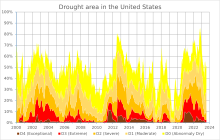





The southwestern North American megadrought is an ongoing megadrought in the southwestern region of North America that began in 2000. At least 24 years in length, the drought is the driest multi-decade period the region has seen since at least 800 CE. The megadrought has prompted the declaration of a water shortage at Lake Mead, the largest reservoir in the United States. Climate change models project drier conditions in the region through the end of the 21st century, though climate change mitigation may avoid the most extreme impacts.
Furthermore, global La Niña meteorological events are generally associated with drier and hotter conditions and further exacerbation of droughts in California and the Southwestern United States and to some extent Southeastern United States. Meteorological scientists have observed that La Niñas have become more frequent over time.[2]
- ^ Irina Ivanova (June 2, 2022). "California is rationing water amid its worst drought in 1,200 years". CBS News. Archived from the original on January 13, 2023. Retrieved June 4, 2022.
- ^ Seth Borenstein, Associated Press science writer (May 28, 2022). "Weather's unwanted guest: Nasty La Niña keeps popping up". 9news.com. Archived from the original on February 27, 2023. Retrieved June 4, 2022.
"Scientists are noticing that in the past 25 years the world seems to be getting more La Niñas than it used to…"